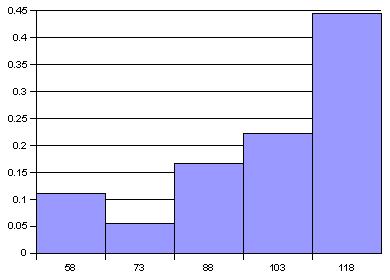| Ten kilometer fun walk fall 2003 Name |
Duration/minutes |
|
|
|
|
|
|
|
| Daniel S. |
43 |
|
|
|
|
|
|
|
| Elvis |
57 |
|
|
|
|
|
|
|
| Lee Ling |
73 |
|
|
|
|
|
|
|
| Israel |
79 |
|
|
|
|
|
|
|
| Aloka |
79 |
|
|
|
|
|
|
|
| Paul |
86 |
|
|
|
|
|
|
|
| Joshua |
94 |
|
|
|
|
|
|
|
| Branson |
98 |
|
|
|
|
|
|
|
| Tosiwo |
98 |
|
|
|
|
|
|
|
| LJ |
101 |
|
|
|
|
|
|
|
| Jake |
105 |
|
|
|
|
|
|
|
| Penina |
105 |
|
|
|
|
|
|
|
| Charles |
111 |
|
|
|
|
|
|
|
| Emmanuel |
111 |
|
|
|
|
|
|
|
| Edwin |
113 |
|
|
|
|
|
|
|
| Ermine |
115 |
|
|
|
|
|
|
|
| Dalina |
117 |
|
|
|
|
|
|
|
| Daniel M. |
118 |
|
|
|
|
|
|
|
|
|
|
|
|
|
|
|
|
| ratio |
1. Determine the level of measurement of the data. |
|
|
|
|
|
|
|
| 18 |
2. Determine the sample size n. |
|
|
|
|
|
|
|
| 43 |
3. Determine the minimum. |
|
|
|
|
|
|
|
| 118 |
4. Determine the maximum. |
|
|
|
|
|
|
|
| 75 |
5. Determine the range. |
|
|
|
|
|
|
|
| There is no mode |
6. Determine the mode. |
|
|

|
| 99.5 |
7. Determine the median. |
|
|
| 94.61 |
8. Determine the mean x. |
|
|
| 21.32 |
9. Determine the standard deviation sx. |
|
|
| 0.23 |
10. Determine the coefficient of variation. |
|
|
| 15 |
11. Determine the bin width. Use 5 bins. |
|
|
|
12. Fill in the following table with the bin upper limits in the first column, the frequencies in the second column, and the relative frequencies in the third column. |
|
|
|
Bins |
Frequency |
Relative Frequency f/n |
|
58 |
2 |
0.11 |
|
73 |
1 |
0.06 |
|
88 |
3 |
0.17 |
|
103 |
4 |
0.22 |
|
118 |
8 |
0.44 |
|
Sums: |
18 |
1 |
|
13. Sketch the relative frequency histogram. |
|
|
|
14. What is the shape of the distribution? |
|
|
|
15. Calculate the 95% cconfidence interval for the population mean duration: |
|
|
|
|
|
|
|
| tc |
2.11 |
|
|
|
|
|
|
|
| Error E |
10.6 |
|
|
|
|
|
|
|
|
84.01 |
≤ μ ≤ |
105.21 |
|
|
|
|
|
|
P( __ ≤ μ ≤ __ ) = 0.95 |
|
|
|
|
|
|
|
|
16. The college had last hosted a 10k in 1996. In 1996 the mean duration was 103 minutes (1.7 hours). Does our confidence interval include 103 minutes? |
|
|
|
|
|
|
|
|
17. Consider the following hypothesis test: |
|
|
|
|
|
|
|
|
|
|
|
|
|
|
|
|
|
H0: μ = 103 minutes |
|
|
|
|
|
|
|
|
H1: μ ≠ 103 minutes |
|
|
|
|
|
|
|
|
|
|
|
|
|
|
|
|
|
Do we «fail to reject the null hypothesis» or «reject the null hypothesis»? |
|
|
|
|
|
|
|
| -1.67 |
t |
|
|
|
|
|
|
|
| 0.11 |
18. Determine the p-value. |
|
|
|
|
|
|
|

